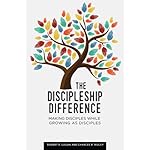
“Would you tell me, please, which way I ought to go from here?” “That depends a good deal on where you want to get to,” said the Cat. “I don’t much care where –” said Alice. “Then it doesn’t matter which way you go,” said the Cat. “– so long as I get SOMEWHERE,” Alice added as an explanation. “Oh, you’re sure to do that,” said the Cat, “if you only walk long enough.” — Lewis Carroll, Alice in Wonderland
Knowing your destination in the journey of discipleship is important. You need to have clarity in terms of where you’re trying to go—it’s a necessary step for getting there. Like Alice, everyone ends up somewhere eventually if they keep walking, but not necessarily where they want to be.
Part of the challenge of discipleship is not being clear on what a disciple is, does, or looks like. Most often, when I am consulting with church leaders and I ask them what they want their disciples to be able to do, the answers are very vague. Certainly in the most general sense, the goal is to become more like Jesus.
But can we get more specific?
When asked what the greatest commandment was, Jesus replied, “You must love the LORD your God with all your heart, all your soul, and all your mind. This is the first and greatest commandment. A second is equally important: Love your neighbor as yourself. The entire law and all the demands of the prophets are based on these two commandments.” (Matthew 22:37-40)
Love God with all your heart, soul and mind and love your neighbor as yourself. That summarizes the essence of a disciple. Another way of articulating that kind of holistic approach is “head, hands, and heart.” We can engage in the same kind of works Jesus did (John 14:12), and we can make more disciples just as he commanded us in the Great Commission (Matt 28:19-20).
Love God, Love Others, Make Disciples
In my house church, we run off the paradigm of Love God, Love Others and Make Disciples. Under each of those three broad categories, we have listed more specific “Life Commitments” around what that looks like, including questions we can ask one another about each of those areas:
LOVE GOD
- Relationship: How are you deepening your experience with God?
- Transformation: How is God changing your life?
- Responsiveness: How has the Holy Spirit been prompting you?
LOVE OTHERS
- Authenticity: In what ways are you being genuine with those around you?
- Respect: How have you had opportunity to value people?
- Involvement: How are you relationally engaged with others?
- Service: How have you been the hands and feet of Jesus?
MAKE DISCIPLES
- Discern: In whom do you see God working?
- Explore: What conversations have you had about spiritual things?
- Invite: Who have you encouraged to become followers of Jesus?
- Establish: How are you helping new believers follow Jesus?
- Multiply: How are you helping new followers make more followers?
 If you’d like to see the behavioral expressions beneath each of these twelve areas, you can download the free document from the resources section of my website. It’s called ViaCordis 12 life commitments.
If you’d like to see the behavioral expressions beneath each of these twelve areas, you can download the free document from the resources section of my website. It’s called ViaCordis 12 life commitments.
Try thinking through the specifics of what a disciple can or should look like in your own ministry context. What qualities or behaviors are you trying to develop? It can be an eye-opening exercise.
Purchase, The Discipleship Difference, here.
The Discipleship Difference: Making Disciples While Growing As Disciples
The Discipleship Difference lays out an intentional, holistic, and relational approach to discipleship that is individualized to meet each person wherever they are.
As an Amazon Associate I earn from qualifying purchases.
Price: $14.99


